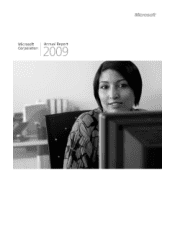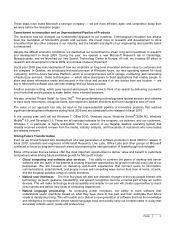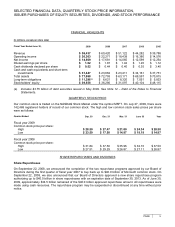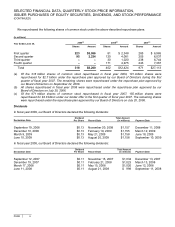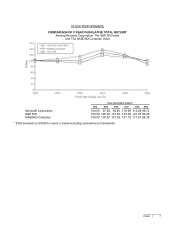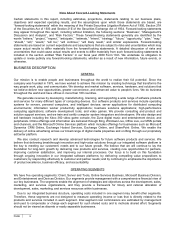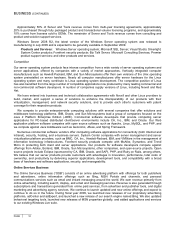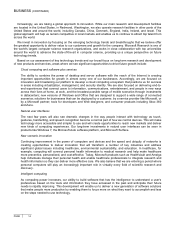Microsoft 2009 Annual Report Download - page 9
Download and view the complete annual report
Please find page 9 of the 2009 Microsoft annual report below. You can navigate through the pages in the report by either clicking on the pages listed below, or by using the keyword search tool below to find specific information within the annual report.
PAGE 9
Client
Client has overall responsibility for technical architecture, engineering, and delivery of our Windows product family
and is responsible for our relationships with personal computer manufacturers, including multinational and regional
original equipment manufacturers (“OEMs”). Client revenue growth is directly impacted by growth of PC purchases
from OEMs that pre-install versions of Windows operating systems because the OEM channel accounts for over
80% of total Client revenue. The differences between unit growth rates and revenue growth rates from year to year
are affected primarily by changes in the mix of OEM Windows premium edition operating systems licensed as a
percentage of total OEM Windows operating systems licensed (“OEM premium mix”). Additional differences in
growth rates result from the impact from lower cost netbook PCs, which are sold with a lower cost version of
Windows, changes in geographic mix, and changes in the channel mix of products sold by large, multi-national
OEMs versus those sold by local and regional system builders.
The majority of revenue in fiscal year 2009 came from sales of Windows Vista, which was released in fiscal year
2007. Windows XP operating systems reached end-of-life for most editions and sales channels (Windows XP Home
Edition will continue to be available on netbooks and other Windows XP editions will continue to be available in
China). Windows 7, the latest version of Windows, was released to manufacturing in July 2009 and is expected to be
generally available on October 22, 2009.
Client offerings consist of premium and standard edition Windows operating systems. Premium editions are those
that include additional functionality and are sold at a price above our standard editions.
Products: Windows Vista, including Home Basic, Home Premium, Ultimate, Business, Enterprise, and
Starter Edition; Windows XP, including Professional, Home, Media Center, and Tablet PC Edition; and other
standard Windows operating systems.
Competition
Client faces strong competition from well-established companies with differing approaches to the PC market.
Competing commercial software products, including variants of Unix, are supplied by competitors such as Apple,
Canonical, and Red Hat. Apple takes an integrated approach to the PC experience and has made inroads in share,
particularly in the U.S. and in the consumer segment. The Linux operating system, which is also derived from Unix
and is available without payment under a General Public License, has gained some acceptance, especially in
emerging markets, as competitive pressures lead OEMs to reduce costs and new, lower-price PC form-factors gain
adoption. Partners such as Hewlett-Packard and Intel have been actively working with alternative Linux-based
operating systems.
The Windows operating system also faces competition from alternative platforms and new devices that may
reduce consumer demand for traditional PCs. Competitors such as Apple, Google, Mozilla, and Opera Software
Company offer software that competes with the Internet Explorer Web browsing capabilities of Windows products.
User and usage volumes on mobile devices are increasing around the world relative to the PC. OEMs have been
working to make the Google Android mobile operating system more compatible with small form-factor PCs or
netbooks.
Our operating system products compete effectively by delivering innovative software, giving customers choice
and flexibility, a familiar, easy-to-use interface, compatibility with a broad range of hardware and software
applications, and the largest support network for any operating system.
Server and Tools
Server and Tools develops and markets software server products, software developer tools, services, and solutions.
Windows Server-based products are integrated server infrastructure and middleware software designed to support
software applications built on the Windows Server operating system. Windows Server-based products include the
server platform including targeted segment solutions, database, storage, management and operations, service-
oriented architecture platform, and security and identity software. The segment also builds standalone and software
development lifecycle tools for software architects, developers, testers, and project managers. Server products can
be run on-site, in a partner-hosted environment, or in a Microsoft-hosted environment.
We offer a broad range of consulting services and provide product support services that assist customers in
developing, deploying, and managing Microsoft server and desktop solutions. We also provide training and
certification to developers and information technology professionals about our Server and Tools, Microsoft Business
Division, and Client platform products.

